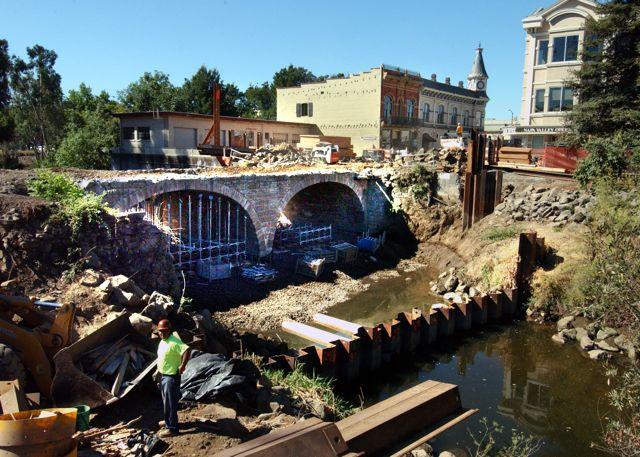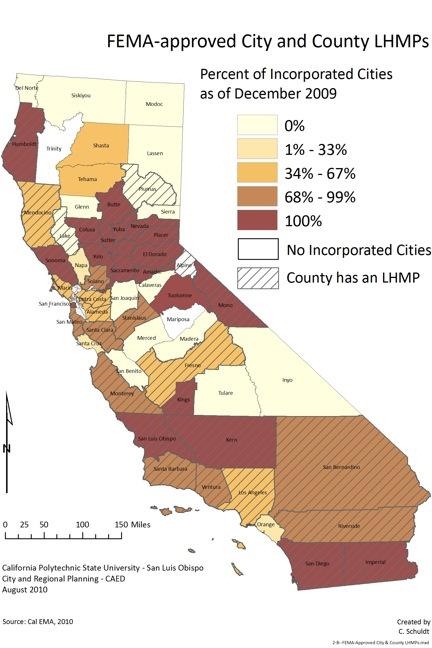Disaster Mitigation Planning Builds Sustainable Communities
Ken Worman is chief of the Hazard Mitigation Planning Division and state hazard mitigation officer for the California Emergency Management Agency.
California is an extraordinarily large and diverse state as well as the most populous, with 38 million people. Protecting its complex social, economic and environmental assets from commonly destructive hazards — such as earthquakes, floods and wildfires — is critically important. However, disaster losses have been growing in recent decades, threatening the state’s sustainability.
The California Emergency Management Agency (Cal EMA), in addition to its emergency response and preparedness planning, is working with local government and private sector partners to help build greater long-term disaster resilience, thus protecting California’s economic and general well-being. Through hazard mitigation planning, Cal EMA strives to minimize losses and response costs as well as facilitate quicker, less costly recovery statewide.
The Federal Emergency Management Agency (FEMA) has designated the 2010 State of California Hazard Mitigation Plan (SHMP) as an Enhanced State Mitigation Plan, which qualifies the state and its localities for increased hazard mitigation grant funds. The SHMP provides an updated and comprehensive description of the state’s historical and current hazard analysis, mitigation strategies, goals, and objectives for reducing loss of life and property from hazards such as earthquakes, floods and wildfires.
The SHMP also reflects a proactive strategy and the state’s commitment to reduce, prevent or eliminate potential risks and impacts of natural and human-caused disasters and keep our families, homes, businesses, communities and visitors to California as safe as possible. The plan can be found at http://hazardmitigation.calema.ca.gov/plan/state_multi-hazard_mitigation_plan_shmp.
The state plan represents California’s primary hazard mitigation guidance document for cities, counties, special districts and tribal jurisdictions seeking to prepare or update their Local Hazard Mitigation Plan (LHMP). By January 2010, California had 324 cities, 37 counties and 388 special districts with FEMA-approved, locally adopted LHMPs, for a total of 749 local jurisdictions with LHMPs.
Why the 2010 SHMP Is Important to Your City
The 2010 SHMP is important to California as a cooperative statewide strategy for reducing disaster losses and building overall resilience. It:
- Protects California’s economy and environment from preventable losses;
- Helps bring funding to state and local hazard mitigation initiatives and projects;
- Assesses mitigation progress;
- Creates benchmarks for future action; and
- Provides a coordinating frame of reference for state-local mitigation actions.
In these ways, the 2010 SHMP helps create more resilient and sustainable urban and rural communities throughout California.
It’s in your city’s best interests — for financial, health and safety reasons — to make sure your city council has adopted an LHMP. Local adoption and FEMA approval of an LHMP is a precondition for eligibility to receive federal hazard mitigation grant funds. Adopting an LHMP as part of the safety element of your General Plan also makes your city eligible for additional post-disaster financial benefits.
Benefits of Mitigation Planning
FEMA approval of the SHMP provides the basis for the state and local governments to receive federal post-disaster recovery and mitigation grant funds. FEMA approval of the 2007 SHMP enabled California to receive approximately $200 million following disasters that occurred between January 2007 and December 2009. This amount included $160 million in Public Assistance infrastructure restoration grants and $40 million in Hazard Mitigation Grant Program grants. Without a FEMA-approved SHMP, California and its cities would not have received these funds. The 2010 SHMP ensures a continuing flow of grant funds to support city improvements that reduce repetitive disaster losses and enhance sustainability.
The purpose of hazard mitigation is to reduce or eliminate the long-term risk to human life and property from natural, human-caused and technological hazards and their effects. Examples of mitigation actions include structural retrofit to reduce potential damage from earthquakes, vegetation management to reduce potential damage from wildfires, and appropriate development regulations to reduce damage from flooding.
Tools Available to Local Governments
Local governments can access technical assistance and guidance in several ways. Cal EMA supports and assists local governments in developing LHMPs and tracks the progress and effectiveness of plan updates and projects. It provides local governments with information on integrating hazard identification, risk assessment, risk management and loss prevention into a comprehensive approach to hazard mitigation and helps them identify cost-effective mitigation measures and projects.
Cal EMA’s hazard mitigation web portal (http://hazardmitigation.calema.ca.gov/) presents the most current news regarding mitigation grants, guidance on how to create a hazard mitigation plan, tools for evaluating hazard risk throughout the state and examples of local hazard mitigation plans (LHMPs) completed within California.
MyPlan: Coming Soon
MyPlan, an online geographic information systems (GIS) mapping tool designed specifically for local governments to use in creating and updating local hazard mitigation plans, will be added to the Cal EMA hazard mitigation web portal in the near future. Cal EMA and the California Natural Resources Agency are jointly creating MyPlan as a new service website providing one-stop access to GIS hazards mapping useful in preparing and updating LHMPs, General Plan safety elements, Local Coastal Plans and hazard mitigation grant projects. MyPlan is expected to go online in the fall of 2011.
Ongoing Outreach
The State Hazard Mitigation Team continues to implement and monitor the SHMP through four work groups. These groups have been meeting quarterly since 2009 and welcome local governments’ participation. The GIS Technical Advisory Working Committee is building the MyPlan website to help local governments develop more effective local hazard mitigation plans and implement hazard mitigation grant projects. The Cross-Sector Communications Work Group is promoting mitigation communications between the public and private sectors and at the statewide and local levels. The Land Use Mitigation Work Group is encouraging land use-based hazard mitigation. The Mitigation Progress Monitoring Work Group is monitoring mitigation on a state and local level.
For more information on participating in these efforts, contact Julie Norris, Cal EMA; e-mail: julie.norris@calema.ca.gov.
This article appears in the October 2011 issue of Western
City
Did you like what you read here? Subscribe
to Western City



